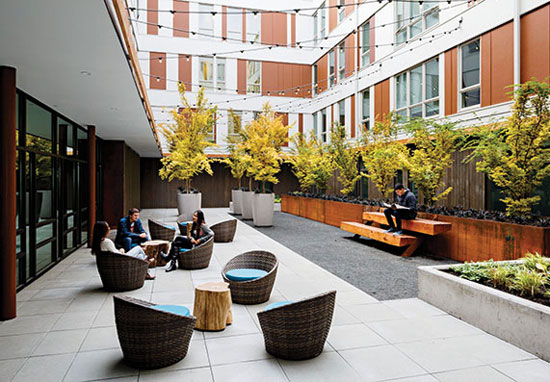Modern Building Codes: Keeping Pace with the Wood Revolution
Sound Transmission and Acoustics
As with any issue of building performance, the acoustics of a wood building can be designed to meet or exceed minimal requirements, depending on the expectations of the developer, buyers and tenants.
In residential buildings, the IBC provides a minimum design requirement for unit-to-unit acoustical protection between floors. It requires a Sound Transmission Class (STC) rating and Impact Insulation Class (IIC) rating of 50, unless the “Authority Having Jurisdiction” has its own more stringent requirement, which is rarely the case.9
Wood-frame construction is particularly efficient in residential buildings where sound insulation is required. Attaching gypsum board to walls and ceilings using resilient metal channels significantly reduces sound transmission, as does placing glass-fiber or rock-fiber insulation within wood-frame floor and wall assemblies.10
That said, the design of any functional and safe building is difficult if not impossible without considering acoustics, and wood has a proven record in this regard. Wood is not as acoustically lively as other surfaces and can offer acoustically absorptive qualities, hence its widespread use in performance and musical venues. At the Arena Stage at the Mead Center for American Theater, for example, a small theater called “The Cradle” posed a challenge because of the sound reflections caused by its oval shape. In response, Bing Thom Architects developed a wood slat wall system made from poplar, designed to look like a basket weave, which could absorb and disperse sound.
The Evolution of Wood Construction
Growing recognition of wood's benefits continues to increase its appeal in many building types, while new products and technologies expand the possibilities for how and where wood is used.
Mid-rise/multi-family. Mid-rise buildings are typically Type V Construction, which allows the use of untreated wood throughout, or Type III Construction. Type III Construction allows the same methods of construction as Type V except the exterior walls are required to be of non-combustible construction, which allows the use of fire retardant-treated wood.
Many developers and design teams default to wood for mid-rise buildings up to four stories because it is the most economical choice; however, with five-story wood buildings permitted in the IBC (six for office occupancy), there has been a marked interest among those who see taller wood buildings as a way to achieve greater density at lower cost. Podium structures in particular, which include multiple stories of residential wood-frame construction over a concrete (3-hour-rated) podium deck, are common among design professionals seeking to incorporate parking, retail or restaurants into their designs. The specific requirements for using podium construction to increase allowable number of stories are detailed in Section 510 of the IBC.
Schools. The IBC has well-established parameters for wood-frame schools, which is good news for school districts trying to accommodate increasing enrollment on a limited budget. However, many who turn to wood-frame construction for its cost effectiveness find that wood also offers other advantages—such as speed of construction, design versatility and the ability to meet green building goals. Increasingly, research is also supporting the idea that visual wood in a room promotes the well-being of occupants, reduces stress and creates a positive environment for learning.
For example, one study11 at the University of British Columbia and FPInnovations found that the presence of visual wood surfaces in a room lowered activation of the sympathetic nervous system (SNS) in an office environment. The SNS is responsible for physiological stress responses in humans such as increased blood pressure and heart rate while inhibiting the parasympathetic system responsible for digestion, recovery and repair functions. Study author David Fell says the results of the office study apply to any interior environment—and they are, in fact, supported by another more recent study of wood in healthcare environments.12 “The stress-reducing effects we found for wood in office environments are in theory transferable to any building type as these are innate reactions to natural materials.”
At the 322,500-square-foot El Dorado High School in Arkansas, designers used exposed wood and natural light to create an environment that would motivate students to stay in school. “We used exposed wood products in structural systems and in elements such as doors, millwork and trim to provide a unique architectural aesthetic that helps to naturally soften and warm the spaces,” says project architect Blakely C. Dunn, AIA, NCARB and principal of CADM Architecture, Inc. From a code perspective, this project is noteworthy because it was one of the first schools in Arkansas to make extensive use of wood following a change in school board policy that had previously prohibited wood in school construction. In 2008, recognition of wood's safety and performance attributes led the Arkansas School Board to modify its School Facilities Manual to reflect the IBC. It is also noteworthy from a cost perspective. Originally designed in steel and masonry, the school was changed to wood-frame construction for budget reasons—a move that saved the school board $2.7 million.










